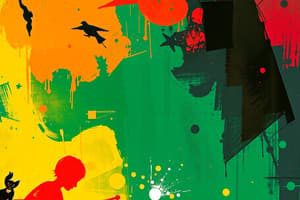Podcast
Questions and Answers
What was Rudyard Kipling's overall impression of Chicago during his visit in 1889?
What was Rudyard Kipling's overall impression of Chicago during his visit in 1889?
- He saw it as a chaotic place filled with greed and horror. (correct)
- He described it as a technology-driven city with a focus on industrialization.
- He found it to be a beautiful and vibrant city.
- He viewed it as a peaceful urban environment.
Which aspect of Chicago's development did Kipling specifically criticize?
Which aspect of Chicago's development did Kipling specifically criticize?
- The rapid expansion of the meatpacking industry.
- The interconnectedness of transportation and communication.
- The lack of aesthetic value and excessive focus on money. (correct)
- The abundance of cultural institutions and beauty.
What metaphor did Kipling use to describe the streets of Chicago?
What metaphor did Kipling use to describe the streets of Chicago?
- A serene landscape.
- A colorful painting.
- A maze of wire ropes. (correct)
- A bustling marketplace.
What did Kipling imply about the opinions of the people he encountered regarding progress?
What did Kipling imply about the opinions of the people he encountered regarding progress?
How did Kipling describe the Union Stock Yards?
How did Kipling describe the Union Stock Yards?
What aspect of American life did Chicago's meatpacking industry exemplify?
What aspect of American life did Chicago's meatpacking industry exemplify?
Which of the following best represents Kipling's view of technology in relation to society during his visit?
Which of the following best represents Kipling's view of technology in relation to society during his visit?
What percentage of the meat consumed by Americans did the Chicago meat processing cartel produce?
What percentage of the meat consumed by Americans did the Chicago meat processing cartel produce?
What was the population of Chicago approximately in 1870?
What was the population of Chicago approximately in 1870?
Which group made up a majority of Chicago's new immigrants by 1890?
Which group made up a majority of Chicago's new immigrants by 1890?
What event leveled a significant portion of Chicago in 1871?
What event leveled a significant portion of Chicago in 1871?
What industry was closely tied to urbanization and immigration in Chicago?
What industry was closely tied to urbanization and immigration in Chicago?
What was significant about the railroads during the industrialization period in the United States?
What was significant about the railroads during the industrialization period in the United States?
By 1900, what percentage of Chicago's population was foreign-born or children of foreign-born immigrants?
By 1900, what percentage of Chicago's population was foreign-born or children of foreign-born immigrants?
What transformation was occurring alongside the evolution of American immigration?
What transformation was occurring alongside the evolution of American immigration?
What was one of the impacts of the railroad expansion post-Civil War?
What was one of the impacts of the railroad expansion post-Civil War?
Which industry became one of the first massive corporations due to the railroads?
Which industry became one of the first massive corporations due to the railroads?
How did industrialization affect farming in America?
How did industrialization affect farming in America?
Flashcards are hidden until you start studying
Study Notes
Rudyard Kipling's Visit to Chicago
- Kipling visited Chicago in 1889, noting a city obsessed with technology and driven by greed.
- Described the city as a "huge wilderness" with overcrowded streets and a lack of beauty.
- Observed that both citizens and taxi drivers viewed industrial advancements as proof of progress.
- Highlighted the stark conditions of the city, with “dirty stone flagging” and chaotic overhead wires.
Industrialization and Meatpacking Industry
- Chicago epitomized American industrial triumph, particularly through its meatpacking industry.
- The meatpacking industry represented a new era for business, characterized by large corporations and trained management.
- A cartel of five firms processed four-fifths of America’s meat supply.
- The Union Stock Yards was the largest meat processing zone, connecting agriculture with national consumption.
- Kipling emphasized the unforgettable sights of the stockyards and slaughterhouses.
Urbanization and Population Growth
- Chicago's population surged from about 30,000 in 1850 to 1.7 million by 1900.
- The Great Chicago Fire of 1871 destroyed 3.5 square miles, but the city quickly rebuilt and expanded.
- By 1920, a majority of Americans lived in urban areas, reflecting broader national trends.
- Initial Chicago immigrants came from Germany, the British Isles, and Scandinavia; by 1890, many were from southern and eastern Europe.
Immigration and Demographics
- In 1900, nearly 80% of Chicago's population was foreign-born or children of immigrants.
- Chicago became a melting pot, with diverse immigrant communities enriching the city's culture and economy.
Changes due to Industrialization
- Industrialization transformed American society with new labor dynamics, mass culture, and wealth concentration.
- Led to urban slums, poverty issues, and the decline of independent farming, while furthering middle-class emergence.
- The railroad industry played a crucial role in creating vast fortunes and massive corporations in the Gilded Age.
Impact of Railroads
- National railroad mileage tripled after the Civil War, facilitating a national market and economy.
- Railroads innovated corporate organization, management techniques, and mobilized significant capital.
- They opened remote markets, created uniform time zones, and connected various regions across the country.
Studying That Suits You
Use AI to generate personalized quizzes and flashcards to suit your learning preferences.




